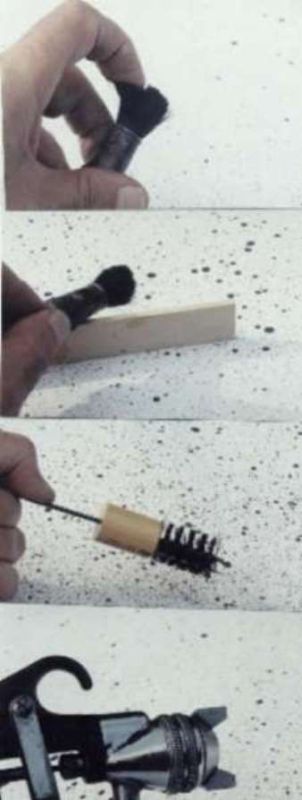Fly Speck Finishes
Techniques for applying fly-speck finishes. April 30, 2006
Question
What do you use to fly speck? Is it a stain, glaze, or pigmented topcoat? And what is the best way to apply it?
Forum Responses
(Finishing Forum)
From contributor M:
Mineral spirits and an oil, japan, or universal color pigmented paste colorant.

Click here for full size image
From contributor R:
I use either Naptha or acetone for a solvent. For a color, I use an oil based UTC, usually a raw umber or a Van Dyke colorant. That's just my preference. For applying the fly specks, I use a two inch throwaway brush, with only half of the bristles remaining. I use a good chisel or set of scissors to remove the excess bristles. I usually want my specks to dry right away so I can continue with my finishing schedule - that's why I'm using Naptha or acetone. Dip the brush about 1/2 inch into the color, fling off the excess onto a sheet of newspaper. Observe the size of the specks once you have gotten rid of the excess color and if the size meets your specks, go for it directly onto your project. As far as applying the specks, hold the brush in one hand and put the thumb of your other hand on the ferrule of the brush. Take your forefinger and flick the utmost top of the brush. Behold... spots, dots and specks. You can vary the size of the dots by flicking off excess material onto the newspaper or by increasing the force of your flicking. Once you've flicked to your heart's content, topcoat with your choice of coatings. Practice for awhile until you get the hang of it. You want your mixture to be thicker than the viscosity of your stain.
From contributor O:
I used a dry glaze. The colors I have used are from black to a dark red, black being the most common. I use a Kremlin M21 gravity gun to apply. I turn the air all but off and slowly turn the fluid on by 1/16 of a turn or less until I get the look I want. This works good producing different size specks. It is also faster than the brush method. The brush method does work good, though.
From contributor M:
I would stay away from the acetone until you know what you are doing, as it could bite into your finish. The mineral spirits, naptha, or a glaze will not eat into a dry coating. Also, if you're not happy with the spattering effect, you can wash it off with either solvent and not harm the finish.
From contributor D:
Glaze with a cut down 1'' brush.
From the original questioner:
Thanks for all of the responses - great info!
